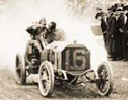Keeping It Off the Wall
by Ed Donath
Backtalk From a Back-stabber
6/3/04
Athens, NY—If only the New York Times would always present flip-flopping policy statements of candidates, politicians, and other public figures in as fair-and-balanced a manner as it recently composed the web page to which an opinion piece by Roger Penske (as told to Dave Caldwell) was launched on 5/30/04. The complete text of the Indianapolis 500 race-day story follows:
BACKTALK—The Brickyard, My Backyard: It's Time to Repair the Rift in Our Sport.
The Indianapolis 500, in my mind, is still the greatest auto race in the world. I went to the Indianapolis Motor Speedway for the first time with my dad in 1951. We had lousy seats. But something in my DNA told me I wanted to be either a car driver or an owner. So I kept coming back. After you get past 30 years, you know you're hooked.
This will be my 49th Indy 500 as either a spectator or as a car owner. Penske Racing has two drivers in today's race, Hélio Castroneves and Sam Hornish Jr. I've missed only the five years after the split in 1996 between the Indy Racing League and Championship Auto Racing Teams, the two major associations in the sport.
Including Gil de Ferran's victory last May, our drivers have won this race 13 times. And yet I'm excited about winning for the 14th time. I like the pressure. You can't go back within the race and do it again. If you make a mistake, you have to wait 12 months.
I like the challenge, too. The buildup is like the two weeks leading up to the Super Bowl. If it were easy, I guess I'd have 100 cars there, to give me a better chance. And we've been at Indy for so long that we worry about more things than most of the other teams do, because we've had a lot of experiences. There are so many things that can happen.
I was a road racer until I retired in 1965 to open a Chevrolet dealership in West Philadelphia. I've owned an Indy-car team since 1968 and now have a team on the Nextel Cup Series in Nascar, Penske Racing South, with Rusty Wallace, Ryan Newman and Brendan Gaughan as drivers. But the acclaim for winning the Indy 500 is enormous.
If you ask any driver from any racing series — a Formula One driver, or an Indy-car driver or, yes, even a Nascar driver — which race he or she would most like to win, I'd bet he or she would say the Indy 500. Once you win this race, it puts you in a special class. But it is like winning the World Series without the National League.
The I.R.L. and CART are still split. My goal, over the next couple of months, is to come up with a way to repair the split that led me away from Indianapolis for five years. I'd like to see one group, not two, racing Indy cars again. It would benefit not only Tony George, the president of the Indianapolis Motor Speedway.
You ride in the pace car with the winner after the race, and you know you've been in a special event. There has been a lot of evolution in this sport, but it's still the same racetrack, and the race still has the same prestige. But we don't see the big infield crowds at Indianapolis that we've seen over the years.
The trajectory of Indy-car racing is not down. It's not flat. The quality of the race teams has improved. There's support for the series within the automotive industry. The sponsorships are strong. In the future, we will need to find one sponsor who will be able to do for Indy-car racing what Nextel can do for stock car racing.
I think Tony George will be able to land a first-class sponsor for the I.R.L. Hopefully, that's on the horizon. If we have such a corporate sponsor for one series, with 35, 36, 37 cars available to compete regularly, I think it would lead to more competitive races and a better series over all than the two separate series we have now.
In each of the last two years, there have been reports that there might not be enough cars to fill the traditional 33-car starting grid. That's economics. The old days of $15,000 cars and having only two sets of wheels are long gone. You can't win this race with merely any car, just as you can't win the Kentucky Derby with merely any horse.
I do think you're going to see more teams migrating from CART over to the I.R.L. I think Buddy Rice winning the pole position this year for the car owner Bobby Rahal, who was a critic of Tony George before the split, was a positive step. It's still going to take some time. You can't have conflict without some fallout.
As strong as stock car racing has become, you couldn't have two major series competing against each other. Besides, Nascar didn't get where it is in four or five years. It took a long time. Some of the people who left after the I.R.L.-CART split are only migrating back now, like Rahal and Michael Andretti, who is now a car owner.
That's encouraging. But I'd like to see us take the next step. I think one series would benefit not only the sport, but also the businesses that surround the sport. I've used Indianapolis as a common thread in all my businesses. When I first went there as a car owner in 1969, I could see that the race could give us a brand identity.
I'd like to see all of the top Indy-car drivers here. To think that more than 400,000 people will be at the race, I don't know of a sporting event that can compare. This place fosters teamwork. The fellow who takes the car in the truck is as important as the driver of the car. If the car doesn't get here, the driver doesn't race.
I remember what happened in 1995 when we had two former Indy 500 champions, Emerson Fittipaldi and Al Unser Jr., fail to qualify for the race. We didn't go back until 2001, and Castroneves won two straight years. De Ferran won last year. So we have not lost an Indy 500 that we've actually competed in since 1992.
Going to the Indy 500 is like going to the Kentucky Derby. But I didn't know what I had been missing until I came back. Now is the time for everyone to come back.
That the Penske piece is a barely coherent collection of carefully selected reminiscences is not what sticks in this renegade scribe’s craw. It is the sheer hypocrisy of one of the greatest rift-makers of all time now exercising the unmitigated gall of calling for the repair of a split that was unilaterally initiated—and has been unilaterally perpetuated—by the inheritor of the Indianapolis Motor Speedway.
Roger Penske has chosen to be aligned with and to defend and further enable the splitter of our beloved speed sport from the day that he abandoned CART a few years ago. Since then, Penske’s prognostications on the ultimate outcome of the open-wheel war have consisted mostly of doom-saying pronouncements regarding Champ Car racing’s chances of survival and of the repeated smarmy prediction that open-wheel racing’s re-unification will occur only after the collapse or abolition of the former CART and/or any upstart replacement company.
CART, incidentally, was formed by Penske and friendly rival U.E. “Pat” Patrick after a rift [what else?] developed between the sanctioning body of the Indy 500 and that of races run elsewhere by Penske, Patrick, and the other notable parties who subsequently occupied the team ownership roster of Championship Auto Racing Teams.
I’m sure you also “remember what happened in 1995” along with Captain Roger when his non-qualification embarrassment occurred, at least partially, because the loophole in the Indy 500 rulebook that allowed Team Penske to throw copious amounts of cash at a dominant, if not over-boosted, “stock block” Mercedes engine was closed. Penske had turned the very race that he professes to so love and cherish into a bizarre anti-techno money circus in 1994.
Then, in 1996 while Penske was still a founding CART franchise holder and the owner of the super-speedway at Brooklyn, Michigan, he gladly hosted the protest US 500 at that venue, further thumbing his nose at the traditionalism of the race that had hooked him by his very DNA.
Ironically, prior to this Backtalk piece, the last time the New York Times saw fit to run anything by or about Roger Penske was on the morning of the inaugural US 500. That story from the Business/Financial section of the paper is referenced at the bottom of the web page on which this current piece is published. The opening sentence of the May 1996 story is also listed:
Challenging the venerable Indianapolis 500 by staging a rival auto race at your own speedway with some of the world's top drivers may be the height of brashness…
Here in my backyard—if I can stop laughing out loud at the lefty Times finally getting it right—it’s obvious that rift repairs can never be accomplished by the likes of the eternal double-agent, Roger Penske.
Copyright © 2004 by Ed Donath and Deep Throttle. All Rights Reserved.
Ed Donath Archive
| 



